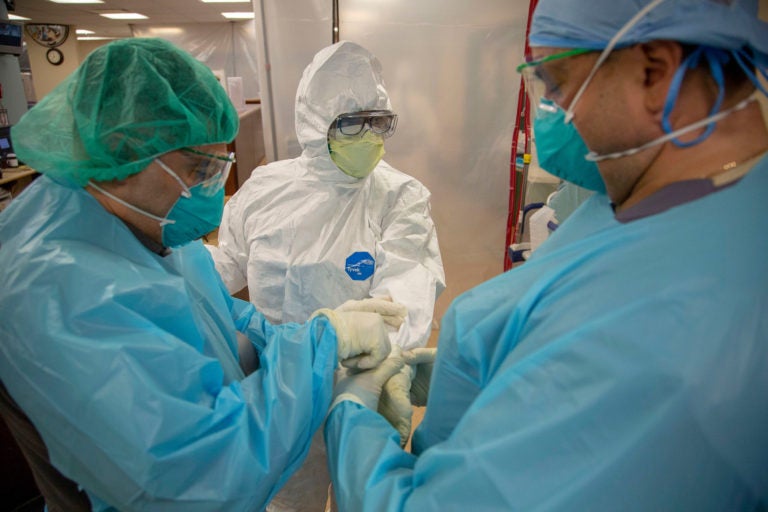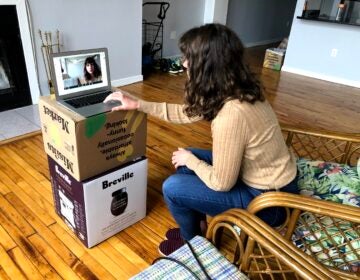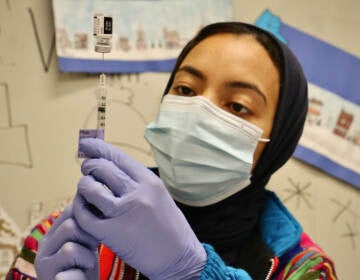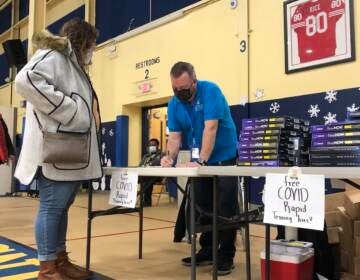Philly area hospitals grapple with shortage of drugs to put patients on ventilators
It’s not just the ventilators: Hospitals are short the sedatives and painkillers used to keep patients on those ventilators during the coronavirus pandemic.
Listen 1:41
It’s not just the ventilators: Hospitals are short the sedatives and painkillers used to keep patients on those ventilators during the coronavirus pandemic. (Jeff Rhode/Holy Name Medical Center)
As hospitals prepare for shortages of protective equipment for medical workers and ventilators for COVID-19 patients, another resource is getting harder to find: the drugs used to put patients on those ventilators.
Breathing through a ventilator and a tube is unnatural for the human body, said David Mihalic, director of inpatient pharmacy at Einstein Medical Center Montgomery.
“You don’t even have to be conscious for your body to not want that tube inside of [it],” he said. “Your body’s kind of rejecting the tube and moving around, possibly pulling the tube out and dislodging it.”
That’s why doctors use a sedative on patients breathing through a ventilator, painkillers to reduce the feeling of the tube being there, and in some cases, paralytic drugs to keep a patient from moving.
And COVID-19 patients need to be on ventilators for a week or two, longer than, say, patients who have had surgery, who only need them for two to three days said Steven Sheaffer, associate professor of clinical pharmacy at University of the Sciences and a committee member for the American Society of Health System Pharmacists.
All three kinds of drugs are in short supply, according to an April 6 survey from the Pennsylvania Society of Health System Pharmacists. In particular, the society found that more than 20% of Pennsylvania hospitals were close to having no supplies for two common paralytic drugs at the time of the survey. More than half may run out of sedatives this week.
“This problem in terms of drug shortages is unprecedented, and like nothing, hospitals have dealt with ever before,” Sheaffer said.
The American Society of Health System Pharmacists wrote to Vice President Mike Pence on April 1, warning that “ventilators will be rendered useless without an adequate supply of the medications” and manufacturing must increase immediately. Some health experts have even written to states that have the death penalty, asking them to release their supplies of paralytic drugs and sedatives that are stored for executions. The Drug Enforcement Administration recently increased production quotas for some of the drugs needed.
Mihalic said that if all COVID-19 patients at his hospital had to be put on ventilators, there would be enough paralytic drugs to last four or five days.
He said pharmacists had to work with clinical staff to think of ways to use less of the drugs, or use different drugs. For example, for patients who can take it, they might move from a drug that is continuously given in an infusion, to a drug that can be pushed every once in a while, so fewer medications are needed. But that comes with tradeoffs: Instead of just setting a regular infusion, pharmacists and nurses now have the extra task of making sure the patient gets their regular dose.
Mihalic said there is a more serious problem: a lack of metered dose inhalers that expand a patient’s airways and help them breathe more easily. These are the same inhalers used by people who have asthma. The problem is so serious that the Food and Drug Administration approved the first generic inhaler last Wednesday.
Not all health care providers in the area face the same challenges.
Temple University Hospital is a pulmonary and transplant hospital, so it already has a fair amount of patients on ventilators and also the drugs for them, said chief medical officer Tony Reed. But he added that the hospital’s supply of those drugs started running low in the last couple of weeks, so they also had to think about using other drugs that can do the same things.
David Showalter, system director of pharmacy services at Main Line Health System said they have coped by diverting resources from the various locations within their network.
Why are there drug shortages? Mihalic says that’s because like a lot of other things, drug companies make their products on a “just in time” model, only making as much of the drug as they know they’re going to sell in a certain time period.
“I’m sure that the pharma companies of the world that were making paralytic agents or sedative agents or opioids knew what they were going to make for a year, not planning for a pandemic,” Mihalic said.
He added that hospital systems like his order drugs from wholesalers that make sales based on historical use, not accounting for sudden surges in demand due to a pandemic. He said drug shortages are almost a fact of life for pharmacists.
“The only time I can recall in my life where there weren’t drugs in short supply was shortly after I graduated from pharmacy school in the late 90s and early 2000s,” he said.
Now, Mihalic said all the pharmacy directors in Pennsylvania have a weekly meeting to share information, so they all know which drugs they are running low on. They also work with local and state politicians to push for help on a federal level, from agencies like the Federal Emergency Management Agency. He said he hopes this pandemic spurs governments to make a playbook for how to deal with these supply chain issues in a disaster, something that survives changes in administration so it doesn’t become a politicized issue.
In fact, government agencies, pharmacists and the major medical associations have been warning about drug shortages for a long time.
Sheaffer was the president of the American Society of Health System Pharmacists back in 2001, and he recalled a 2002 meeting with members of the entire drug supply chain, including the American Medical Association, the American Nurses Association, the Food and Drug Administration and the Pharmaceutical Research and Manufacturers of America.
They talked about precisely how to solve this problem, such as by having drug makers provide more timely information, the FDA inspecting manufacturing sites more often, mandating drug makers to report shortages, and keeping all groups in touch about supply levels.
“And we identified … gaps that needed to be addressed around the supply chain in response to disasters,” Sheaffer said. “You could take that list and say we haven’t done anything to close these gaps … There’s a lot of work to do.”
WHYY is your source for fact-based, in-depth journalism and information. As a nonprofit organization, we rely on financial support from readers like you. Please give today.





![CoronavirusPandemic_1024x512[1]](https://whyy.org/wp-content/uploads/2020/03/CoronavirusPandemic_1024x5121-300x150.jpg)


